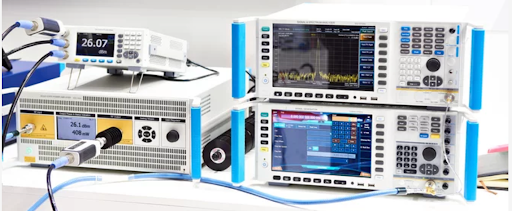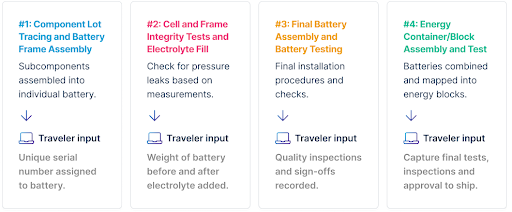Advanced materials companies across a variety of industries face common challenges in managing their lab data as part of R&D, which can only be addressed by a LIMS solution. About 60% of labs report data silos as a significant challenge1 in managing and threading their data, causing process inefficiencies and even data loss. Perhaps more than in most industrial settings, manual data entry is still quite common and can account for up to 30% of the lab staff’s time, increasing costs and introducing risk of error and slowing down operations considerably.
In this month’s issue, we’ll look into the common data management challenges in labs across three industries dealing with advanced materials, and how a laboratory information management system (or LIMS solution) can address these issues. We’ll also explore how Peaxy Innovate provides a comprehensive integrated and flexible LIMS with advanced data threading capabilities, customizable workflow management and advanced metrology and electrochemical test analytics.

Laboratory Information Management Systems (or a LIMS solution) automate data capture and threading in R&D processes across a range of industries. Labs commonly struggle with automated data collection and storage, often involving large amounts of data from multiple proprietary systems. A LIMS solution aids in not only centralizing lab data, but making it queryable, secure, and compliant.
Manufacturing and Materials Testing
The uses of a LIMS solution in manufacturing where materials testing is common are quite varied. As an example, in optical analysis, R&D teams face the challenge of managing diverse data types, including spectral data, imaging results, and material properties. The integration of various data sources and OEMs is often cumbersome, leading to inefficiencies and potential data loss2. LIMS can streamline data integration by providing a unified platform for all data types, ensuring consistency and accuracy. It can also automate routine tasks such as data entry and complex analysis, and establish an audit trail to manage sample data. Capabilities can even extend into inventory and resource management, providing inventory levels of materials and reagents, how often equipment is used and by whom, as well as resource allocation and capacity planning. A LIMS solution, however, should not be a “one size fits all” and should be flexible enough to accommodate the unique and potentially complex workflows for each customer.
As another example, concrete production is characterized by the need to manage data from various stages of the production process, including raw material testing, mix design, and performance evaluation3. The challenge lies in maintaining data consistency and ensuring that all relevant data is available for analysis and decision-making. A LIMS solution can help by integrating data from different sources and standardizing workflows. This not only improves data accuracy but also facilitates better quality control and compliance with industry standards. By automating data management processes, a LIMS solution helps manufacturing and R&D teams to optimize their workflows, enhance productivity and manage and track the entire quality control process from raw materials to finished product, limiting product recalls and enhancing market size.
Electrochemical
Advanced materials and R&D for products such as batteries, particularly in the field of electrochemical tests, involves handling large volumes of experimental data, including physical characteristics, chemical compositions, electrochemical performance, and environmental conditions4. The primary challenges are to ensure data integrity and facilitate real-time data analysis. LIMS can address these challenges by integrating with analytical instruments to automate metrology data capture and by providing a centralized data repository. This reduces the risk of data loss, enhances the accuracy of experimental results, and speeds up results. Furthermore, a LIMS solution can support advanced data analytics, enabling researchers to derive meaningful insights from their data and accelerate the development of new materials4 and batteries. Again, LIMS should not be a “one size fits all” and should be flexible enough to accommodate the unique and potentially complex workflows for each customer.

By capturing product specifications, metrology data and ECT data in LIMS from materials and products before a battery is produced at volume, it becomes possible to query and associate downstream life cycle data with parameters that went into the battery, in a fully automated fashion. That same data can be used to generate reports at any point in the process to track against quality and compliance standards.
In battery manufacturing, automating metrology and electrochemical tests streamlines data management and enhances quality control throughout the production process, with seamless integration into manufacturing execution systems (MES) to manage complex workflows, from raw material testing to in-process monitoring and final product quality assurance. The in-line tests can readily identify materials and cells not meeting specification requirements before batteries are shipped to customers. As readers are aware, routine workflows as part of rigorous performance and safety testing generate large amounts of data including test output as well as metadata related to instrumentation and calibration. A LIMS solution can centralize this data and provide a clear and intuitive reporting view in a format appropriate for compliance and management review.
Automating sample scheduling and results management ensures that all relevant data is accurately logged and easily traceable – essential for maintaining high standards of product performance and safety. This centralized data management not only improves efficiency but also helps manufacturers quickly identify and address any issues, thereby protecting brand reputation and ensuring regulatory compliance for lifetime tracability. Overall, automating metrology and electrochemical tests with LIMS is a vital tool for optimizing battery manufacturing processes and supporting the development of high-performance, cost-effective energy storage and mobility solutions.
Biotech Research
Bio materials R&D involves handling vast amounts of complex data, from genetic sequences to biochemical assays. One of the primary challenges is ensuring data integrity and traceability, especially when dealing with regulatory requirements and compliance standards. Traditional data management methods often lead to fragmented data silos, making it difficult to maintain a cohesive and accessible data repository. A LIMS solution can centralize data storage, particularly while documenting sample preparation, ensuring all information is not only easily accessible and traceable, but reproducible and compliant. Samples can include biological, environmental, chemical, microbiological, and genomic. It also automates data capture and documentation processes, reducing the risk of human error and enhancing compliance with regulatory standards including HIPPA and ISO standards.
Peaxy Innovate: A Complete LIMS Offering
Peaxy Innovate, part of Peaxy Lifecycle Intelligence (PLI), offers a comprehensive integrated and flexible LIMS tailored to the needs of advanced materials and product R&D. With its data threading capabilities, PLI ensures that all data is seamlessly integrated and easily accessible. This is particularly beneficial for managing complex datasets and ensuring data integrity across different stages of the R&D process.
Along with this, PLI offers flexible, customizable workflow management solutions, allowing R&D teams to tailor the system to their specific needs, automating data collection at every step, thus enhancing productivity and ensuring that all regulatory and compliance requirements are met.
PLI’s ability to manage workflows through a user-friendly point and click interface simplifies the data management process, reducing the risk of errors and improving overall efficiency. PLI also automates complex analytics required to quickly characterize materials and products to identify specification improvements and increase the availability of test equipment such as a limited number of cyclers. By providing a centralized platform for all R&D data, PLI facilitates better collaboration and accelerates the innovation process.
Conclusion
Implementing a LIMS solution offers substantial benefits for advanced materials R&D, improving operational efficiency up to 40%, as it automates routine tasks, complex analytics and streamlines workflows. This automation not only reduces the time spent on manual data entry, which can account for up to 30% of laboratory time, but also significantly decreases the risk of human error by up to 80%5. Laboratories and testing environments using a LIMS solution report a reduction in sample turnaround times, facilitating faster decision-making and accelerating R&D processes. The centralized data storage provided by LIMS can also lead to cost savings of 15-20% by eliminating the need for multiple, fragmented storage systems, and ends up mostly paying for itself.
Effective data management is essential for the success of R&D in advanced materials. LIMS offers a powerful solution to the common challenges faced by R&D teams, ensuring data integrity, enhancing collaboration, and improving compliance. Peaxy Innovate stands as a comprehensive LIMS solution, providing comprehensive data threading capabilities, advanced analytics and customizable workflow management to meet the unique needs of each industry. What’s clear is that more industries can benefit from LIMS than traditional lab coat environments. Whether it’s optical, concrete, advanced materials, electrochemical processes as part of battery development, or bio materials (to name a few), Peaxy Innovate offers a robust solution to the data management challenges faced by R&D and manufacturing teams.

